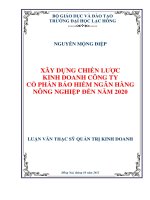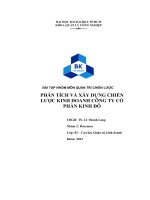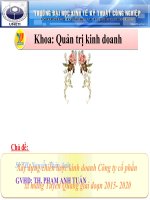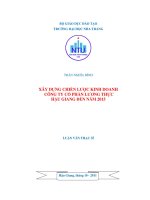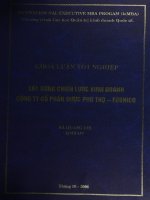Xây dựng chiến lược kinh doanh công ty cổ phần khoáng sản VIGACERA
Bạn đang xem bản rút gọn của tài liệu. Xem và tải ngay bản đầy đủ của tài liệu tại đây (639.64 KB, 91 trang )
LUẬN VĂN
Xây dựng chiến lược kinh doanh công ty cổ phần khoáng
sản VIGACERA
THESIS MBA
BUILDING BUSINESS-LEVEL STRATEGY
VIGLACERA MINERAL JOINT STOCK COMPANY
PERIOD 2015 - 2020
HANOI, 2010
1/91
2/91
TABLE OF CONTENT
LIST OF ABBREVIATIONS.................................................................................5
LIST OF TABLES...................................................................................................6
LIST OF FIGURES, GRAPHS..............................................................................7
INTRODUCTION...................................................................................................8
1. Rationale of the Study......................................................................................................8
2. RESEARCH OBJECTIVES...........................................................................................9
3. SCOPE OF STUDY..........................................................................................................9
4. STUDY METHODOLOGY............................................................................................9
5. REPORT STRUCTURE..................................................................................................9
Theoretical BASIS.................................................................................................10
1.1. BUSINESS STRATEGIES FOR BUSINESS...........................................................10
Figure 1.1: Business strategy.............................................................................................12
1.2. SELECTING AND PLANNING BUSINESS STRATEGY....................................14
Figure 1.2: Strategic planning process.............................................................................17
Figure 1.3: Macro Environment.......................................................................................20
Figure 1.4: PEST model.....................................................................................................21
Figure 1.5: Michael Porter's five forces of competitive position model........................22
Figure 1.6: Value chain......................................................................................................24
Figure 1.7: Map SWOT analysis.......................................................................................26
Figure 1.8: SWOT Matrix.................................................................................................28
Figure 1.9: IE Matrix.........................................................................................................31
ANALYSING CURRENT STATUS OF..............................................................36
VIGLACERA MINERAL JOINT STOCK COMPANY...................................36
2.1. ABOUT COMPANY ..................................................................................................36
Figure 2.1: Organizational models of the Company.......................................................37
2.2. ANALYSIS MACRO ENVIRONMENTAL AFFECTING ACTIVITIES OF THE
COMPANY..................................................................................................................46
2.3. ANALYSIS INDUSTRY ENVIRONMENTAL AFFECTING ACTIVITIES OF
THE COMPANY.........................................................................................................50
2.4. OPPORTUNITIES AND THREATS FOR COMPANY.........................................58
From the results in Table 2.5, we can see that the Company achieved a total score of
3.03; on 2.5 points - a medium level. This means that Company can meet the
3/91
external factors in an effort to pursue strategies for the use of the opportunities
outside as the stable rate of economic growth, improve the business environment,
and take advantage of opportunities for competitors..............................................60
However, the Company should pay attention to factors affecting the success of the
Company that the Company also hasn’t a good response as interest credits,
recruitment, and some general policy of the State on minerals..............................60
2.5. INTERNAL ENVIRONMENTAL ANALYSIS AFFECT ACTIVITIES OF THE
COMPANY..................................................................................................................60
Figure 2.4: Map technological lines of the Company......................................................63
Figure 2.5: Positioning the companies in the market......................................................66
2.6. STRENGTHS AND WEAKNESSES FOR COMPANY.........................................69
Through Table 2.8, shows the total score of 3.13, higher than the average level of 2.5;
which the Company has an environment with good internal strength such as
application of new technologies for production, experience and production
activities, brand goods, customers, service after sale, and management. This is the
core competence of the Company..............................................................................71
However, still many weak points such as price, production capacity, distribution,
training and developing human resources................................................................72
2.7. ANALYSIS OF IE MATRIX.....................................................................................72
From EFE Matrix and IFE Matrix, position the Company in IE Matrix as follows: 72
Figure 2.6: IE Matrix of Company...................................................................................72
Currently, the company is in cell I. Company should develop and build strategy.
This means to carry out an extensive strategic and positive. Strategy should focus
on market penetration, market development and product development..............72
2.8. SWOT ANALYSIS......................................................................................................72
SELECTION OF STRATEGIC BUSINESS.......................................................78
AND PROGRAM IMPLEMENTATION............................................................78
3.1. CRITERIA OF SELECTION STRATEGY.............................................................78
3.2. RESULTS EVALUATION SELECTION STRATEGY.........................................78
3.3. ACTION PROGRAM IMPLEMENTATION STRATEGY...................................84
3.4. SOLUTIONS IMPLEMENTATION STRATEGY.................................................84
CONCLUSION......................................................................................................89
REFERENCES......................................................................................................90
4/91
LIST OF ABBREVIATIONS
Abbreviation
FX
FM
FK
GDP
ASEAN
AFTA
WTO
SWOT
EFE
IFE
IE
QSPM
Interpretation
The symbol of feldspar bone products
The symbol of feldspar enamel products
The symbol of feldspar glass products
Gross Domestic Product
Association of Southeast Asian Nations
ASEAN Free Trade Area
World Trade Organization
Strength - Weakness - Opportunity - Thread Analysis
External Factor Evaluation Matrix
Internal Factor Evaluation Matrix
Internal - External Matrix
Quantitative Strategic Planning Matrix
5/91
LIST OF TABLES
6/91
LIST OF FIGURES, GRAPHS
Figure 1.1: Business strategy.............................................................................................12
Figure 1.2: Strategic planning process.............................................................................17
Figure 1.3: Macro Environment.......................................................................................20
Figure 1.4: PEST model.....................................................................................................21
Figure 1.5: Michael Porter's five forces of competitive position model........................22
Figure 1.6: Value chain......................................................................................................24
Figure 1.7: Map SWOT analysis.......................................................................................26
Figure 1.8: SWOT Matrix.................................................................................................28
Figure 1.9: IE Matrix.........................................................................................................31
Figure 2.1: Organizational models of the Company.......................................................37
Figure 2.4: Map technological lines of the Company......................................................63
Figure 2.5: Positioning the companies in the market......................................................66
Figure 2.6: IE Matrix of Company...................................................................................72
7/91
INTRODUCTION
1. RATIONALE OF THE STUDY
In recent years, Vietnam's economy moves gradually from the economic
planning focus, bureaucracy should be subsidized to a market economy. This
transition and international integration makes Vietnam's economy has gradually
developed. Numerous state enterprises were stock stood firm and gradually asserted
his role in the economy. Viglacera Mineral Joint Stock Company is one of the
enterprises converted from state-owned companies into joint stock companies, is
one of the company's mining and mineral processing as raw materials for industrial
production of construction materials (ceramic tiles, glass, porcelain ...).
A business required succeeding in the right direction, there are flexible and
changing in accordance with its business environment. A proper business strategy
and a team fully capable of organizing the implementation of strategies to help
companies capture, take advantage of opportunities and limit the risks, develop the
strength and overcome the weaknesses in order to achieve above average returns.
Viglacera Mineral Joint Stock Company is a small and medium companies
have weak financial capability, just out of planning mechanism focused, narrow
lines of business, the business environment is not stable, the construction business
strategy for the Company is a very important job. But for many different reasons
that this problem is less interested. A major reason the Company is a member of
Viglacera Corporation. The production plan previously established mainly based on
the plan was delivered Corporation. Business strategy of the Company to stop at the
development and implementation of business plans every quarter and the year,
according to the plan of the Corporation. The long-term plan, providing strategic,
often created sketchy, lacking scientific. Another part is due to the lack of
theoretical basis, lack of skills building strategies. So the Company has no strategy
of its business in accordance with what it means. Derived from the actual needs
with the desire to apply knowledge learned in applications where members of the
working group. Therefore, the group agreed selected topic "Building business-level
8/91
strategy Viglacera Mineral Joint Stock Company - Period 2015 - 2020" as the
subject of the research group.
2. RESEARCH OBJECTIVES
- Based on the theory we have learned to manipulate reality to enhance
business efficiency of production and business, reduce costs, deliver higher profits
for businesses, improving enterprise's value and thereby increase effective social.
- Apply the theoretical basis, the analysis tools to build a business strategy is
suitable for business.
- Draw out the action plan to implement the strategy.
- Proposed solutions and recommendations for Company on the
implementation of this strategy.
3. SCOPE OF STUDY
Due to limited time and resources should we go further research and build
business strategies for the business's current business, do not consider expanding
lines of business into other areas.
4. STUDY METHODOLOGY
- Study of the theory of building strategies - use of reference.
- Collecting data at the enterprise and the information on the Internet.
- Analysis assessment and quantitative strategies to choose.
5. REPORT STRUCTURE
Title of the research: "Building business-level strategy Viglacera Mineral
Joint Stock Company - Period 2015 - 2020"; except the introduction, conclusion
and references, is structured into sections as follows:
Chapter 1: THEORETICAL BASIS
Chapter 2: ANALYSING CURRENT STATUS OF VIGLACERA
MINERAL JOINT STOCK COMPANY
Chapter 3: SELECTED BUSINESS STRATEGY AND PROGRAM
IMPLEMENTATION
9/91
Chapter I
THEORETICAL BASIS
1.1. BUSINESS STRATEGIES FOR BUSINESS
1.1.1. The concept of business strategy
As usual means and strategies (derived from the original Greek word is
strategos) is a military term used to refer to the battle plan layout and distribution of
forces with the aim of votes wins enemies. Carl von Clausewitz - the tactic of the
19th century - has described the strategy is “war planning and planning campaigns
warfare. The campaign he will determine the participation of individual”. More
recently, historian Edward Mead Earle described the strategy is “the art of
controlling and using resources of a country or a coalition of countries aimed to
ensure and increase the efficiency of their vital interests”.
Today, business organizations also apply the concept of strategy is similar to
the military. Strategy is planned and controlled use of organizational resources such
as people, property, financial ... aims to enhance and ensure the vital interests of
there. Kenneth Andrews was the first to offer ideas in the book highlights classic
The Concept of Corporate Strategy. According to him, strategy is what an
organization must rely on their strengths and weaknesses in the context with the
opportunities and threats.
Bruce Henderson, strategist at the same time is the founder of Boston
Consulting Group has connections with the concept of strategic competitive
advantage. Competitive advantage is setting a company in a better position to create
competition on the economic value for customers. Henderson wrote that “Search
strategy is a prudent action plan to develop and combine competitive advantage of
organizations. The difference between you and the competition is the basis for your
advantage”. Henderson believes the two cannot coexist if the competitor's business
they are identical. Need to make a difference may exist. Michael Porter also
received the approval of Henderson: “Competitive strategies related to the
10/91
difference. That is the carefully selected a series of different activities to create a
unique set of values”.
Can see that in all definitions of strategy have appeared phrases express the
different aspects should be included in it. Therefore, requires the definition of a
multifaceted strategy, Mintzberg has launched with five P defined as follows:
Plan: a series of actions intended to consistently.
Pattern: is being consistent behavior over time, may be intended or not
intended.
Position: the match between the organization and its environment.
Perspective: is to realize how deeply about the world.
Ploy: is a specific way to trick opponents.
1.1.2. Nature of the business strategy
Is similar to military strategy, competitive strategy of an organization aims to
achieve conformity between the capacity difference and the environment outside the
organization involved competitive. However, compared to military strategy,
strategic business more complicated. Unlike military conflict, competition in
business is not always bringing local losers with winners. The competitions in the
industry sometimes have the opportunity to improve the strength and skills as egg
competition. The value of the capacity difference bring competitive advantage to
organizations can be reduced over time by the changing environment. Due to the
possibility that this strategy not only competitive, but includes a few can be a
different decision. The important thing is to always discover new opportunities,
prevent and repel potential threats, to overcome the current weaknesses and the
power shifted to new areas (see Figure 1.1). Every business must cope with the
strategic decisions continuously. However, a number of strategic decisions can
become urgent computer and bring in some louder than any period depends on the
specific context.
11/91
Opportunities
Strengths
Application
Maintenance
Discover
Strategy
Strategy
Inside
Pass
Outside
Prevent
Threats
Weaknesses
Figure 1.1: Business strategy
(Source: Pro. /PhD Le The Gioi, Dr. Nguyen Thanh Liem, MBA. Nguyen Huu Hai
(2009), Strategic Management, Statistics Publisher)
1.1.3. Characteristics of business strategy
In business, to achieve long-term success, the enterprise should constantly
upgrade their competitive advantage over time. Fundamental problem that every
business should be resolved when choosing business strategies, namely: choice of
products and services will be provided to customers; how to create products and
services; and how to make the products, services to customers. Thus, business
strategy has the following basic characteristics:
• Business strategy clearly defines the objectives and basic directions of
business enterprises in each period.
• Up-oriented strategy to ensure business continuity and development firm
in the business environment often fluctuates.
• Business strategy ensures maximum mobilize and combine optimal
exploitation and use of enterprise resources in the present and future, to
promote the advantages and seize opportunities to gain advantage in
competition.
• Business strategies of the business are reflected throughout the process of
continuous.
• Business strategy always thought advancing, winning victory in the
market business.
12/91
• Business strategy is usually built in a long period (3, 5, 10 years).
1.1.4. The overall competitive strategy
There are many different strategies to compete, but a general there are three
basic approaches to creating competitive advantage, it is: Cost leading strategy,
Differentiation strategy, Focusing strategy. Three ways are referred to as "generic
strategies”, because they can be applied to any industry with large scale or small, all
products and services. In 1985, three general strategies have been Michael Porter
first introduced in the classic book "Competitive Advantage: Creating and
sustaining Superior Performance".
Each strategy as a result consistently selected the company's products,
markets and the ability to make a difference, these options also affect each other.
Table 1.1: Main features of overall business strategy
Create differences
of the product
Market segment
Ability to create
differences
Cost leading
Differentiation
strategy
Low (mainly by
strategy
High (mainly in
price)
Low (big volume
the unique)
High (many
or unique)
Low (one or
market)
Manufacturing and
market segments)
Research and
several segments)
materials
development, sales
management
and marketing
Focusing strategy
Low to high (price
Ability to create
any difference
(Source: Pro. /PhD Le The Gioi, Dr. Nguyen Thanh Liem, MBA. Nguyen Huu Hai
(2009), Strategic Management, Statistics Publisher)
1.1.4.1. Cost leading strategy
Strategy of cost leading is overall of actions in order to provide the product
or service which have features affected by customer with the lowest cost in relation
to all competitors. In other words, strategies leading cost based on the ability of
businesses to provide products or services with lower costs than competitors. The
purpose of person who being pursued the strategy of leading cost is better than
13/91
competitors, so that the cost of manufacturing and supply of any product or service
is lower than competitors.
1.1.4.2. Differentiation strategy
The target of general strategy to make a differentiation is to achieve the
competitive advantage of company by creating products (goods or services) which
realize unique in some important characteristics by customers. Company which
makes a difference trying to satisfy customer’s demand by the way those
competitors cannot do with intention of increasing price requirement (a significant
price in industry average). The increased price of person who make the difference is
often higher than the price which the person of leading cost require and customers
willingly pay because they trust about the quality of different products, which has
distinctive value.
1.1.4.3. Focusing (concentration) strategy
Centralization strategy is a series of actions needed to produce goods and
services to serve the demand of a specific segment of competitive market. The main
difference with two above strategies is that it directly serves demand of the group or
limited segment of customers. A centralization strategy will focus to the specific
slot of market that can be determined the terms of geography, customer type, or
segment of the product channel.
1.2. SELECTING AND PLANNING BUSINESS STRATEGY
1.2.1. Strategic planning process
An effective business strategy together with the implementation of
excellence is the best guarantee for the success of any organization. A business
survive in a changing environment, including changes in: technology, social values,
consumer habits, economic conditions, policies and even the standards on pollution
environment can see the risks, challenges and great opportunities.
Leaders and senior researchers may give the reasons why enterprises should
conduct strategic business planning. One of the main reasons that make the Glueck:
14/91
• Condition of most business changes so fast that strategic planning is only
one way to counter these problems and opportunities in the future.
• Strategic planning to provide all members of the business objectives and
specific directions for future business.
• Strategic planning as a basis for control and evaluation management.
• Organizations and individuals planning strategy will succeed and achieve
more effective planning is not.
The process of planning business strategies, including the basic steps: setting
goals, evaluating current location, building strategies, preparing and implementing
strategic plans, evaluating and adjusting plans.
* Setting business goals.
Building objectives or goals that enterprises want to achieve in the future.
Objectives must be realistic and to quantify exactly what businesses want to be. In
the process of strategic planning, targets special needs are: sales, profits, market
share, reinvestment.
* Evaluating current location.
There are two areas to assess: evaluate the business environment and
evaluate the resources:
-
Evaluate the business environment: Research on the business
environment to determine what factors in the current environment is a
risk or opportunity for the goals and strategies of the business. Assessing
the business environment, including factors such as economic and
political events, technology, market pressures, relationships and social.
-
Evaluate the resources: Full analysis of strengths and weaknesses of the
company on the side: management, marketing, finance, production
activities, research and development.
* Building strategies.
After completing the evaluation, will move to phase selection. To be
selected, should consider these variables as well as internal force variables
15/91
objectively. The choice is usually clear from all the relevant information in the
evaluation of the planning process. However, to get the choice, a strategy must be
reviewed by the parts: the cost, using scarce resources, time - the progress, and
related to affordability.
* Preparing and implementing strategic plans.
Preparation and implementation of strategic plans of the two different
processes, but related to each other:
-
Phase
organizations:
the
implementation
process
includes
the
organization of people and resources to strengthen the choice.
-
Phase policy: the development of a policy nature and function to
consolidate, more detailed strategy chosen.
* Evaluating and adjusting plans
At this stage of the process of planning business strategy, senior managers
determine if their selection strategies in the model is consistent with the objectives
of the business. This is the process control and management estimates the additional
common scale.
16/91
Functional tasks and strategic goals
of the business
Analysis of
enterprise’s inside
Analyze the business
environment
Selection strategy
Strategy company level
Strategic business functions and
departments
Implementation strategy
Check and evaluate implementation
results
Feedback
Figure 1.2: Strategic planning process
(Source: Associate Pro. Dr. Ngo Kim Thanh, (2009), Lecture presentation Business Strategy, International Master of Business Administration Program Griggs University)
1.2.2. Vision, mission and objectives of the enterprise
1.2.2.1. Vision
Vision shows the highest goal and desire of general business, describes the
desire of the business about what businesses want to reach. Vision is extremely
important achievement because it is central imagination of people in the
17/91
organization and encourages all efforts to achieve organizational goals, career and
ideas more.
By James Collins and Jerry Porras structure of the vision may include two
basic components:
•
Core ideology: Thought identify core features of a long held, that a
consistency determination has surpassed the life cycle of products or
markets, breakthrough technologies, the management style of individuals
and leaders. In fact, the core ideology make important contributions and
for sustainable success in business long-term vision.
•
Envisioned future: Envisioned future consists of two parts is a
challenging target of 10 to 30 years and vivid descriptions of what the
objectives achieved. On the one hand, as envisioned future convey
specific - what a clear, lively and realistic. On the other hand, it covers a
period not realize the aspirations, hope, dream of it.
1.2.2.2. Mission
Mission of the enterprise is a concept used to define the purpose of the
business, the reasons that business is established and the basis exists, its
development. Mission of business is business manifesto for the society, it
demonstrated the usefulness and significance of the existence of enterprises to
social. The mission statement is a critical order of how a business's perception of
the demands of the parties concerned. The mission statement focuses on the
changes expected of the organization. Focus and mission of the command to release
the potential of the organization, but it is still capable of achieving what is in a
period.
Mission statement describes organizations in terms of business of it, the
customers it serves, and the skills necessary to develop to meet the vision. If vision
is the central achievement of the ideas and goals of the organization, the mission
description vision way less abstract and more realistic. Mission in more strategic
vision, in which it set the direction on how large organizations will achieve or meet
18/91
the vision for a certain period. Mission report describes an overview of the business
customers, products and services primarily, the orientation of the enterprise in a
period.
Mission statement creates the foundation for the entire work plan. It is a
reference point to evaluate the objectives and strategies of the organization.
1.2.2.3. Objectives
Vision and mission is not only the goals or purposes of the tangible, concrete
achievements to aim towards a greater. The goal is the future status of the business
or trying to make the end result of the action plan and objectives determine exactly
what to do if you want to achieve mission. To be meaningful and goal setting are
considered good, the objective must have the basic characteristics:
-
Accurate and measurable.
-
Must be directed to other important issues.
-
Must be challenging but can be done (in fact).
-
Should be identified with a period of time (sometimes correctly) can be
achieved.
-
Provide tools to evaluate the performance of administrators.
1.2.3. Business environment of enterprises
To business success, enterprises must have business strategies suitable
environment for their own advantage by smoothly. There are many factors that
impact on business strategies, including external environmental factors, industry
environment factors, and internal environmental factors.
19/91
Economics
Political
Threat of New
Entrants
Globalization
Bargaining
Power of
Suppliers
Competition
between
rivals
Bargaining
Power of
Buyers
Threat of
Substitute Products
Technological
Demographic
Socio-cultural
Figure 1.3: Macro Environment
(Source: Pro. /PhD Le The Gioi, Dr. Nguyen Thanh Liem, MBA. Nguyen Huu Hai
(2009), Strategic Management, Statistics Publisher)
1.2.4. Analyzing external business environment
PEST model study of the impact of the factors in the external business
environment based on factors:
o
Political forces
o
Economics forces
o
Socio-cultural forces
o
Technological forces
20/91
Figure 1.4: PEST model
(Source: />Here are four factors that directly influence the economic sectors; these
factors are external factors that businesses and industry suffered the effects of it as a
factor brings objectivity. Businesses based on impact to make policy, business suit.
1.2.5. Analysis of the environmental business industry
A branch is a group of companies provide products or services can replace
closely. The competition, companies in sectors affect each other. In general, each
industry will include a diverse mix and competitive strategies that companies
pursue to try to achieve higher income than average. Replacement closely means
products or services meet customer needs basically similar.
Michael Porter - the strategic management famous of the Harvard University
- in his book "Competitive Strategy: Techniques Analyzing Industries and
Competitors" has made the comment about the competitive pressure in all industry
business. By Michael Porter, the strength of competition in the market in an industry
affected any of the five competitive forces:
• Bargaining power of suppliers.
• Bargaining power of buyers.
21/91
• Threat of new entrants.
• Threat of substitute products or services.
• Rivalry among existing competitors.
Figure 1.5: Michael Porter's five forces of competitive position model
(Source: />1.2.6. Analyze internal business environment
1.2.6.1. Resources, potential capabilities, core competence
Resources include a category of organizational factors, technical, material
and human resources, finance and business. Resources can be divided into two
categories: tangible resources and intangible resources. Tangible resources can be
seen and quantified, including financial resources, organizations, physical facilities
and technology. Intangible resources cannot see and cannot be quantified, including
human resources, improved capacity and reputation.
Potential capabilities of the enterprise are the ability to use resources that are
integrated with an aim to achieve a desired goal state. The ability to produce over
time through interaction between intangible resources and tangible, as an
22/91
organization closely linked together. These skills focus on the daily work of the
organization; the way decisions, management processes in order to reach the goals
of the organization. More general, the potential ability of a business is the product
of organizational structure and control system.
Core competence is the resources and capabilities of the enterprise are used
as a source of competitive advantage. Core capabilities create competitive
enterprises and quality of private. Core capability arises from time to time through a
learning process, has accumulated an organization about how to exploit the
resources and capabilities of different. As a possibility of action, the core capability
is “jewelry luxury of a business”; the business activities that perform well compared
to competitors and thereby increase its value to the goods and services in a long
time.
1.2.6.2. Competitive advantages of enterprises
A business is considered a competitive advantage when its profit rate higher
than the average rate in the industry. And businesses have a sustainable competitive
advantage if it can maintain high profit rate in a long time. Two basic factors to rate
the profitability of a business is the amount of value that customers feel about the
goods or services of the business and its production costs.
By exploiting the core competence or competitive advantage to meet and
satisfy both the standard requirements of competition, firms create value for
customers.
Essentially, creating superior value does not necessarily require a business to
have the lowest cost structure in the industry or create products valued in the eyes
of customers, which is important deviation between value aware and production
costs than most competitors. Michael Porter has pointed out that low cost and the
difference are the two basic strategies to create value and gain competitive
advantage in an industry. According to Porter, competitive advantage (as the higher
profits) to businesses, this can create exceptional value. And how to create value,
23/91
are not superior to lower business costs and/or create different products, so
customers evaluate it higher and willing to pay a price increase.
1.2.6.3. Value chain analysis
Value chain, also known as value chain analysis, is a concept from business
management was first described and popularized by Michael Porter in 1985 in his
book entitled: Competitive Advantage: Creating and Sustaining Superior
Performance.
Value chain is a chain of activities. Products go through all the activities of
the chain in order and at each operation, product obtained a value that. Chain of
activities gives the products more added value than the total value of all the
activities combined. It is important not to mix the concept of value chain with the
MINUTES OF
PROFITS
Purchasing
MINUTES OF
PROFITS
(Research and development)
Human Resource Management
Information Systems
Infrastructure
Function support
cost occurred during the operation.
Customer service
Marketing & Sales
Provided external
Production
Provide internal
Main function
Figure 1.6: Value chain
(Source: Pro. /PhD Le The Gioi, Dr. Nguyen Thanh Liem, MBA. Nguyen Huu Hai
(2009), Strategic Management, Statistics Publisher)
24/91
Because the value chain to reflect the activities related to the flow of goods
within the enterprise (mainly activities), activities to support this line of goods
(secondary activities) and activities associated with business as well as other foreign
enterprises, so the Porter value chain analysis is useful in all sectors, although still
the most obvious applications of it with the material flowing through the enterprise.
Biggest benefit of the value chain is that it allows decay to analyze how
companies create products or services, and how to do well. Use this tool to help
identify a specific value is born from nature and where the competitive advantage of
business. Minimum each business unit must be reviewed by a value chain.
Sometimes generate more value chain for a business unit will be very useful if the
products or services do differ.
1.2.7. Model analysis to select strategies
1.2.7.1. SWOT analysis models and four types of strategies
A scan of the internal and external environment is an important part in the
process of planning strategies of enterprises. Environmental factors internal to the
enterprise usually can be classified as strengths (S) or weaknesses (W), and those
environmental factors external to the enterprise can be classified as opportunities
(O) or threats (T). Such an analysis of environmental strategies is referred to as a
SWOT analysis.
The SWOT analysis provides information useful to combine the resources
and capabilities of enterprises in the competitive environment that the business
operates. As such, it is instrumental in the development and selection business
strategy. The following diagram shows how a SWOT analysis in accordance with a
business environment:
25/91


